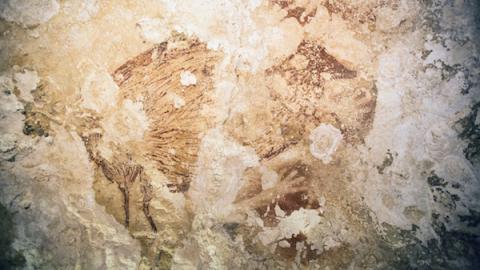Archaeologists have determined that artwork found in limestone caves on the Indonesian island of Sulawesi is far older than previously thought. First documented in the 1950s, the images–stencils of human hands and depictions of animals—were assumed to be less than 10,000 years old. Paintings older than that would not survive in such a tropical environment, so the logic went. But a new study indicates that the Sulawesi art dates back to at least 39,900 years ago, making it as old as (or possibly older than the oldest cave art in Europe).
The discovery has important implications for understanding the origin of cave art and the evolution of Homo sapiens. Archaeologists have long focused on Europe’s ancient art. There was nothing like it of comparable antiquity anywhere else in the world, and the genius for it seemed to come out of nowhere. For tens of thousands of years H. sapiens made only utilitarian objects, such as stone stools for hunting and butchering prey, and then suddenly, after our ancestors expanded out of Africa and into Europe, they started making these wondrous works of art, like the paintings in Chauvet cave in France and the ivory figurines from the Swabian Alps in Germany. And it wasn’t just art that blossomed. The archaeological record indicated that musical instruments and advanced weaponry originated in Europe at around this same time. This state of affairs gave rise to the notion of Europe as a sort of finishing school for our species.
But as researchers began to take a closer look at the evidence from Europe and, importantly, from Africa, a different pattern began to emerge. Many of the sophisticated tools that had once appeared to originate with modern humans in Europe after 40,000 years ago actually debuted earlier in Africa, where H. sapiens got its start roughly 200,000 years ago. Furthermore, anatomically modern H. sapiens wasn’t the only human manufacturing such advanced implements: The archaic Neandertals made them, too. Likewise, artwork and other remnants of symbolic expression, such as shell beads for jewelry have turned up in Africa and these are far older than the oldest European art. And there is now good evidence that Neandertals engaged in symbolic behaviors as well.
There was one thing that seemed to distinguish the art by early modern Europeans, however: whereas the early African art depicts abstract geometric patterns, the early European art is figurative, showing naturalistic representations of animals and humans. So did early modern humans from Africa enter Europe with abstract, nonfigurative art and then develop naturalistic representations gradually in their new homeland? Or had they already developed this sophisticated style of cave art in Africa, before they reached Europe?
The Sulawesi paintings bear on this debate. Announcing their findings in a paper published today in Nature, Maxime Aubert and Adam Brumm of the University of Wollongong in Australia and their colleagues acknowledge that figurative cave painting may have emerged independently in Sulawesi and in western Europe at around the same time, more than 40,000 years ago. (Scientific American is part of Nature Publishing Group.) But more compelling, in my view, is the alternative scenario they describe: namely, that the hand stencils and animal paintings in these two regions separated by some 13,000 kilometers have a common, far deeper origin in Africa. I’m betting that archaeologists will eventually find much older examples of such art in humanity’s motherland.
FURTHER READING: Scientific American special issue on human evolution (September 2014)
Kate Wong is an editor and writer at Scientific American covering paleontology, archaeology and life sciences. Follow on Twitter @katewong.


Spread the word